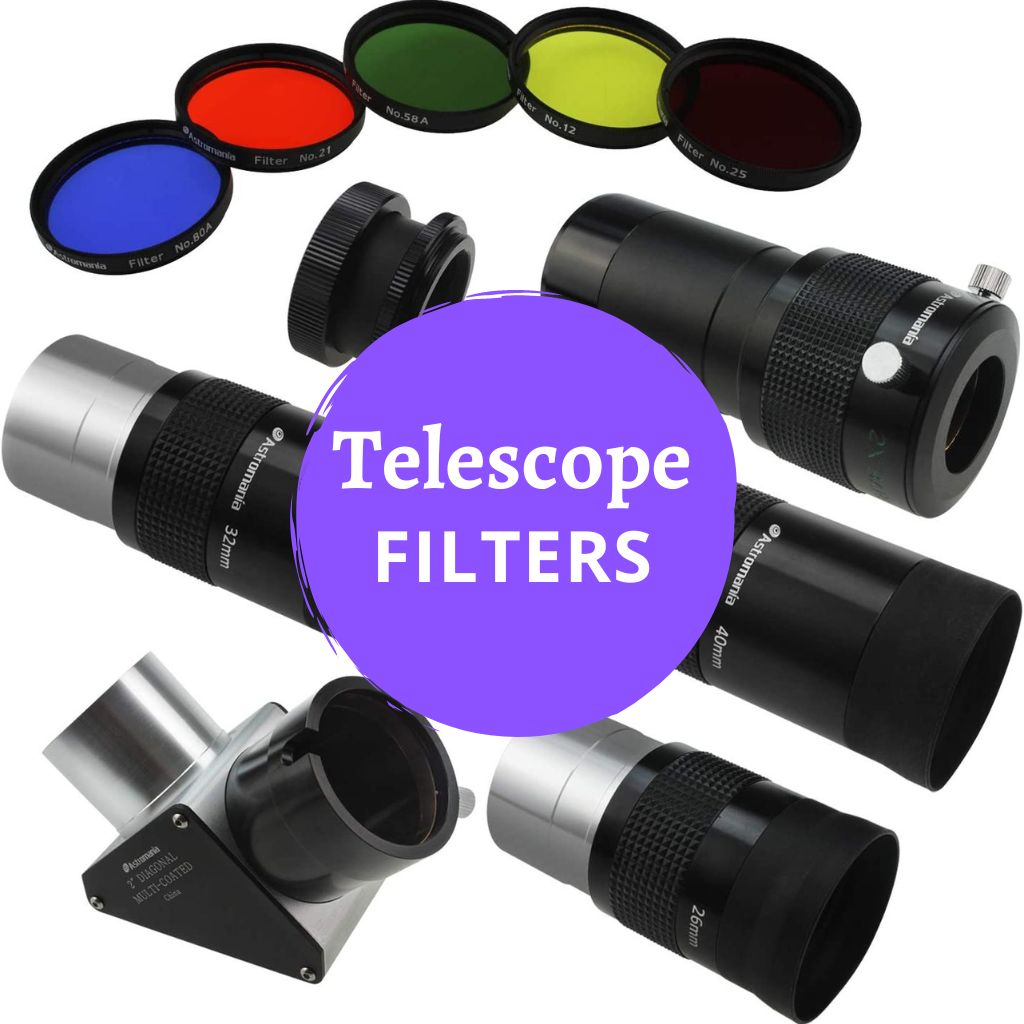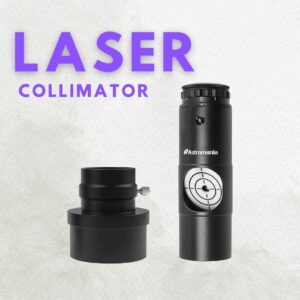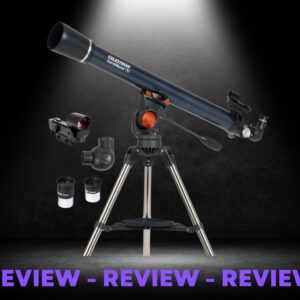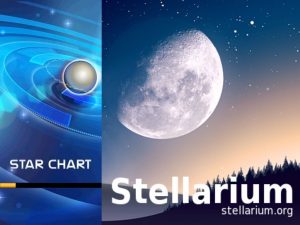This site contains affiliate links to products. I may receive a commission for purchases made through these links.
Telescope filters are small pieces of glass or plastic that can be attached to the eyepiece or telescope itself. They come in different shapes, sizes, and colors, each with its unique effect on the image.
Telescopes have allowed us to peer into the depths of the universe and discover the wonders of space.
However, not all objects in the night sky are equally visible, and sometimes the views can be hindered by light pollution, atmospheric conditions, or even the telescope itself.
Telescope filters solve these problems by enhancing the view and making certain celestial objects more visible. These accessories help improve the quality of astronomical observations by blocking out unwanted light and enhancing specific wavelengths.
In this article, we will explore the various types and models of telescope filters that can help you get the most out of your stargazing experience.
Telescope color filters
Telescope color filters are among the most popular types of filters used by astronomers to enhance their stargazing experience. These filters work by selectively blocking certain wavelengths of light, which can improve the contrast and visibility of some celestial objects.
Best telescope color filters
When it comes to choosing the best telescope color filters, there are several factors to consider, such as the type of telescope you have, the objects you want to observe, and the viewing conditions in your area.
Here are some of the best telescope color filters:
Astromania color filters
Astromania is a well-known brand in the astronomy equipment market, and they offer a range of color filters designed specifically for astronomical observation.
These filters are designed to enhance the contrast and visibility of various celestial objects, such as planets, stars, and galaxies.
Here are some of them:
- The Astromania 2″ Eyepiece and Filter Kit : This includes a set of 5 filters in green, yellow, orange, red, and blue filter. They can be used to enhance the contrast and details of planets, the moon, and deep-sky objects such as nebulae and galaxies.
- Astromania 1.25″ Yellow Filter: Enhances the contrast of features on the Moon and planets.
- Astromania 1.25″ Orange Filter: Helps to bring out the details of Martian surface features and enhances contrast on Jupiter’s cloud belts.
- Astromania 1.25″ Green Filter: Enhances the visibility of subtle details on Mars and Jupiter, and can also be useful for observing Saturn’s atmosphere.
- Astromania 1.25″ Moon Filter: Reduces the brightness of the Moon, allowing for more comfortable and prolonged observation.
Solomark Color Filters
The Solomark Color Filters are a popular product in their filter range, designed to enhance the viewing experience for astronomy enthusiasts by improving the contrast and details of celestial objects.
The Solomark Color Filters are made of high-quality materials and are designed to be compatible with a wide range of telescopes and eyepieces.
Here are some of the color filters from this brand:
- The Solomark 1.25-Inch Telescope Eyepiece and Filter Set: This is a comprehensive kit that includes a range of eyepieces and 5 color filters.
- The Solomark 1.25 Inch 4pcs Color Filter Set: The set includes four color filters – blue, green, yellow, and red filter, – each designed to enhance the viewing experience.
Zhumell Color Filter
The Zhumell Color Filters are made of high-quality materials and are available in different colors, including red, blue, green, and yellow, to fine-tune the colors of the objects being observed.
Here are some of the color filters from this brand:
- The Zhumell 1.25″ Lunar and Planetary Color Filter Set: This is a set of four filters designed to enhance the observation of celestial objects, specifically the moon and planets.
- The Zhumell 1.25″ Eyepiece and Filter Kit: The kit contains five color filters (Red, Blue, Green, Yellow, and Orange) and a neutral density filter.
Celticbird Color Filters
The Celticbird Color Filters Set includes 7 1.25-inch filters with 5 color filters (red, orange, green, blue, and yellow) designed to enhance specific features of the Moon and planets. These filters can be used with telescopes or cameras.
SVBONY Color Filter
The SVBONY Color Filter is a series of filters designed to enhance the views of celestial objects by reducing light pollution and bringing out specific details.
These filters are compatible with a wide range of telescopes and come in a variety of colors to suit different astronomical observations. The brand is known for its affordability, reliability, and customer satisfaction.
Here are some telescope color filters from SVBONY:
- The SVBONY Telescope Filter 1.25 inches: This is a five-color filter set that helps to enhance the views of the lunar and planetary objects.
- SVBONY SV127 Telescope Filter Eyepiece Filter Set: It includes four color filters that are ideal for observing planetary details. These filters can be easily screwed onto the eyepiece.
More options here: SVBONY Filters: All Models & Types Compared
Neewer Telescope Color Filter
NEEWER is a brand that produces a wide range of photography and videography equipment, including lighting equipment, camera accessories, and studio equipment.
The NEEWER brand has gained popularity among professionals and hobbyists for its affordable yet high-quality products.
Here are some telescope color filters from the brand:
- Neewer Telescope Color Filter has a set that includes five 1.25-inch color filters (red, yellow, green, blue, and orange) designed for use with DSLR cameras for astrophotography. These filters can be used to correct color balance or enhance specific features of celestial objects.
- NEEWER Telescope Eyepiece and Filters Kit include six colored filters (blue, green, light green, red, orange, and yellow) that are designed to enhance the lunar and planetary views.
If you want to enjoy your filter kit, consider getting a filter wheel. Filter wheels are essential accessories for astrophotography, allowing you to quickly and easily switch between filters.
Telescope planetary filters
Planetary filters are designed to enhance the observation of planets and other solar system objects. These filters work by selectively blocking certain wavelengths of light that can interfere with the observation and details of the object being viewed.
Best telescope planetary filters
The best telescope planetary filters are designed to enhance the views of planets by reducing light pollution and bringing out specific details in celestial objects.
Here are some of the best planetary filters available:
Lumicon telescope filters
Lumicon filters are made using high-quality materials, ensuring that they provide the best possible image quality. The company’s filters are also known for their durability and longevity, making them a great investment for any serious astronomer.
Some of the popular Lumicon planetary filters include:
- Lumicon Yellow Planetary Filter: This filter enhances the red and orange features of Jupiter and Saturn.
- The Lumicon Color/Planetary Filter Yellow-Green: This is a filter designed to enhance the views of planets by reducing chromatic aberration and increasing contrast.
- Lumicon Green Planetary Filter: This filter enhances the atmospheric features of Mars and Venus and the belts and zones of Jupiter.
Orion 1.25″ Jupiter Observation Eyepiece Filter
Orion 1.25″ Jupiter Observation Eyepiece Filter is designed to enhance the view of Jupiter by reducing glare and enhancing contrast and detail in the planet’s cloud bands and atmospheric features.
Read also: 11 Best Telescopes to See Jupiter (Planet, Red Spot, and Moons)
Baader Planetarium Eyepiece Filter Set
The Baader Planetarium Eyepiece Filter Set 1.25″ 6 Colors FCFS-1 is a set of six filters designed to enhance the views of celestial objects.
Each filter is coated with Baader’s proprietary filter coatings, providing sharp and clear views of the lunar and planetary objects.
You may also like: 21 Best Telescopes to See Planets (Read This First!)
Telescope filters for Nebula
Nebula filters are designed to enhance the visibility of faint gas and dust clouds in deep space. These filters are typically available in narrowband or broadband options, depending on the specific needs of the observer.
Best telescope filters for Nebula
The best telescope filters for nebula are narrowband filters that allow specific wavelengths of light to pass through, blocking out other light that can wash out the nebula details.
These filters are designed to isolate the specific wavelengths of light emitted by the nebula and can significantly enhance the contrast and visibility of the faint details in the nebula.
Below we list some of them.
DGM Telescope Filters
DGM Optics 1.25″ NPB Nebula Filter is designed to enhance the visibility of emission and reflection nebulae by filtering out light pollution and enhancing the transmission of nebular light.
Orion Ultrablock Narrowband Filter
Orion 5657 2-Inch UltraBlock Narrowband Eyepiece Filter is designed to provide high-contrast views of emission and planetary nebulae by blocking out the majority of light pollution and enhancing the transmission of specific wavelengths of light emitted by nebulae.
Solar filters for telescopes
Solar filters for telescopes are designed to allow safe viewing of the sun. They are crucial to protect the observer’s eyes from the sun’s damaging ultraviolet and infrared radiation.
Best solar filters for telescopes
The best solar filters for telescopes are designed to safely observe the Sun and its features, including sunspots, solar flares, and prominences.
These filters use specialized materials that block out harmful ultraviolet and infrared radiation while allowing a safe amount of visible light to pass through.
The best solar filters are as follows:
Celestron Telescope Solar Filters
Celestron Telescope Solar Filters are high-quality solar filters designed to fit Celestron telescopes securely.
Celestron – EclipSmart Safe Solar Eclipse Telescope Filter is ISO 12312-2 compliant. It is designed to work with 8” Schmidt-Cassegrain/EdgeHD Telescopes to observe eclipses and sunspots.
Baader Planetarium AstroSolar Film
Baader Planetarium AstroSolar Safety Film Visual is made of thin and flexible film that can be cut to fit any telescope size. It provides safe and high-quality views of the sun’s surface.
Lunt Solar Systems Hydrogen-Alpha Solar Filter
Lunt Solar Systems 50mm H-Alpha Front Mounted Filter for LS50THa is designed for observing the sun’s chromosphere and prominences. This hydrogen alpha filter provides high-contrast views of these features and is available in various sizes.
Telescope moon filter
Lunar filters for telescopes are designed to reduce the glare of the moon’s surface and enhance contrast, allowing for better observation of lunar details.
Best telescope moon filters
The best telescope moon filters will reduce glare, enhance contrast, and reveal more details on the lunar surface.
Many reputable brands offer high-quality moon filters that are easy to install and compatible with different telescope models.
Here are some of them.
Meade telescope filters
Meade Instruments Series 4000 MoonFilter is an excellent accessory for telescopes with apertures of 4 inches and larger. The filter helps to reduce the brightness of the Moon and enhances contrast, allowing you to observe lunar features in greater detail.
Celestron Moon Filter
Celestron Moon Filter reduces glare and enhances contrast, making lunar details more visible. It is compatible with most telescopes.
Orion Moon Filter
Orion 05662 1.25-Inch 13 Percent Transmission Moon Filter is made of high-quality glass and reduces the brightness of the moon’s surface for better observation of lunar features.
Gosky 1.25″ Moon Filter
Gosky 1.25″ Telescope Moon Filter is made of aluminum and reduces glare and brightness for clearer moon observation.
Light pollution filters
Light pollution filters block out the specific wavelengths of light produced by artificial light sources that cause light pollution.
Doing so enhances the contrast and visibility of deep-sky objects such as galaxies, nebulae, and star clusters.
Best light pollution telescope filters
The best light pollution filters are made of high-quality materials, are easy to install, and have a durable construction.
Several reputable brands offer effective light pollution filters for telescopes, and choosing the right one can make a significant difference in your viewing experience.
Choose one of these:
Celestron UHC/LPR Filter
Celestron 94123 1.25-Inch UHC/LPR Filter blocks out unwanted wavelengths of light, such as those produced by high-pressure sodium and mercury vapor streetlights.
It fits on most standard 1.25-inch eyepieces and comes with a protective case.
Orion SkyGlow Broadband Filter
Orion 5660 1.25-Inch SkyGlow Broadband Eyepiece Filter is designed to combat light pollution and improve the contrast of deep-sky objects.
It works by selectively blocking out the wavelengths of light associated with artificial lighting while allowing the light from celestial objects to pass through.
Baader Neodymium Filter
Baader Neodymium Filter is a multi-coated, broadband filter that enhances the contrast and color of deep-sky objects while reducing the effects of light pollution. It fits on most 1.25-inch eyepieces and comes with a protective case.
Deep-sky telescope filters
Deep-sky filters are designed to enhance the visibility and contrast of celestial objects such as galaxies, nebulae, and star clusters. They work by selectively blocking out certain wavelengths of light and transmitting others.
Best deep sky telescope filters
Here are some of the best deep-sky telescope filters available
Zhumell Telescope Filters
The Zhumell 1.25″ High-Performance O-LLL Telescope Filter is an excellent accessory for astronomers who want to reveal more details of deep sky nebulae.
This filter helps to reduce light pollution and enhances contrast, making it easier to observe faint nebulae and other deep-sky objects.
Lumicon Deep Sky Filter
Lumicon LF3015 2″ Deep-Sky Filter is designed to enhance the visibility of faint nebulae and other deep-sky objects by blocking out certain wavelengths of light that can interfere with the observation.
How to use telescope eyepiece filters
To use your telescope filters, simply insert the filter into the eyepiece barrel and attach the eyepiece to the telescope as you normally would.
Make sure to choose the appropriate filter for the object you are viewing, and follow all safety precautions for solar filters.
For a complete guide on this, check out How to Use Telescope Filters (Beginners Guide)
FAQs about telescope filters
Telescope filters can be a valuable accessory for any astronomer, but it’s important to understand how they work and what they can do. Here are some frequently asked questions about telescope filters
What do telescope filters do?
Telescope filters can enhance the viewing experience by blocking specific wavelengths of light, allowing certain details or features to be seen more clearly.
For example, White light solar filters are used to safely observe the sun without damaging the eyes or equipment.
Polarizing filters are designed to reduce glare and enhance contrast in celestial objects. A variable polarizing filter can be adjusted to control the amount of light that passes through, making it a versatile tool for observing different celestial objects.
Is using eclipse glasses as telescope filters good?
Eclipse glasses are not designed to be used as telescope filters. They are not strong enough to protect your eyes from the intense light and heat of the sun that is magnified by a telescope.
What are the best starter telescope filters?
The best starter telescope filters are the ones that match the objects you want to view.
For example, a moon filter can help reduce the brightness and glare of the moon, while a light pollution filter can enhance the visibility of deep-sky objects.
Some good starter filters include:
Are telescope solar filters safe?
Telescope solar filters are safe if they are specifically designed for viewing the sun and used correctly. It is important to never look directly at the sun without proper protection and to follow all instructions provided with the filter.
What is the best Orion 6 telescope solar filter?
One highly rated solar filter for the Orion 6 telescope is the Thousand Oaks Optical Solar Filter.
How do I use the filters for my Celestron telescope?
If you have a Celestron telescope and wish to use filters, the process is simple. Insert the appropriate filter into the eyepiece barrel and attach the eyepiece to the telescope as usual.
Remember to select the correct filter for the object you are observing, and always adhere to safety guidelines for solar filters.
Can I see double stars or ghosts with telescope filters?
Telescope filters are not designed for viewing double stars or ghosts. They are used to enhance the observation of specific celestial objects by blocking certain wavelengths of light.
How do I attach telescope filters to the mount adapter?
Attaching a filter to the mount adapter can vary depending on the specific telescope and filter being used. It is best to consult the instructions for both the telescope and filter or to contact the manufacturer for guidance.
As a general instruction, the filter is typically threaded onto the eyepiece’s end before being inserted into the telescope’s focuser.
What is the best telescope filter for viewing planets?
Some popular filters for viewing planets include:
What is the best Tasco telescope solar filter?
The best solar filter for Tasco telescopes is the Thousand Oaks Optical Solar Filter.
Takeaway: Telescope filters provide a better and safer viewing experience
Using telescope filters can greatly enhance the viewing experience of celestial objects.
Whether you’re a beginner or an experienced astronomer, many types of filters can help you see more detail, contrast, and color. Choosing the right filter for your telescope and the object you want to observe is important.
Additionally, always follow the manufacturer’s instructions and safety guidelines when using solar filters. With the right filter and proper usage, you can enjoy breathtaking views of the night sky.
You may also like:






















